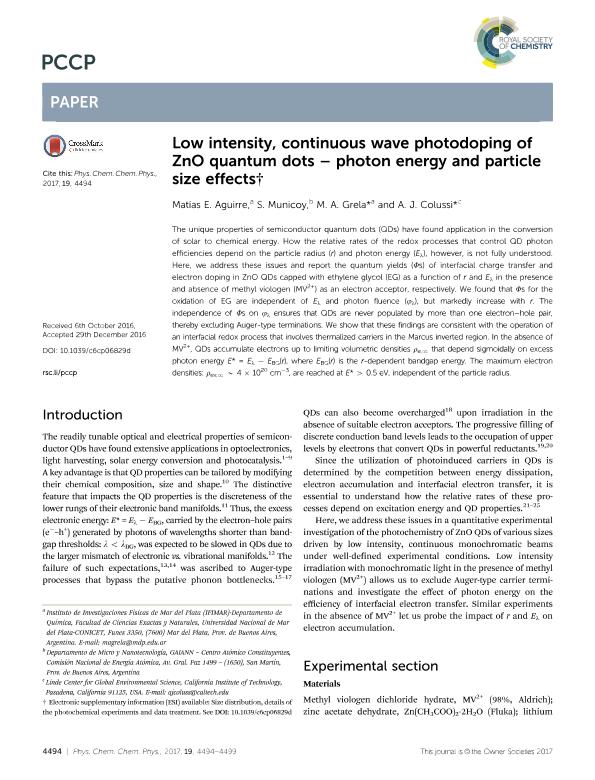Artículo
Low intensity, continuous wave photodoping of ZnO quantum dots - Photon energy and particle size effects
Fecha de publicación:
01/2017
Editorial:
Royal Society of Chemistry
Revista:
Physical Chemistry Chemical Physics
ISSN:
1463-9076
Idioma:
Inglés
Tipo de recurso:
Artículo publicado
Clasificación temática:
Resumen
The unique properties of semiconductor quantum dots (QDs) have found application in the conversion of solar to chemical energy. How the relative rates of the redox processes that control QD photon efficiencies depend on the particle radius (r) and photon energy (Eλ), however, is not fully understood. Here, we address these issues and report the quantum yields (Φs) of interfacial charge transfer and electron doping in ZnO QDs capped with ethylene glycol (EG) as a function of r and Eλ in the presence and absence of methyl viologen (MV2+) as an electron acceptor, respectively. We found that Φs for the oxidation of EG are independent of Eλ and photon fluence (φλ), but markedly increase with r. The independence of Φs on φλ ensures that QDs are never populated by more than one electron-hole pair, thereby excluding Auger-type terminations. We show that these findings are consistent with the operation of an interfacial redox process that involves thermalized carriers in the Marcus inverted region. In the absence of MV2+, QDs accumulate electrons up to limiting volumetric densities ρe,∞ that depend sigmoidally on excess photon energy E∗ = Eλ - EBG(r), where EBG(r) is the r-dependent bandgap energy. The maximum electron densities: ρev,∞ ∼ 4 × 1020 cm-3, are reached at E∗ > 0.5 eV, independent of the particle radius.
Palabras clave:
Semiconductor
,
Quantum Dots
,
Photodoping
,
Size
Archivos asociados
Licencia
Identificadores
Colecciones
Articulos(CCT - MAR DEL PLATA)
Articulos de CTRO.CIENTIFICO TECNOL.CONICET - MAR DEL PLATA
Articulos de CTRO.CIENTIFICO TECNOL.CONICET - MAR DEL PLATA
Articulos(IFIMAR)
Articulos de INST.DE INVESTIGACIONES FISICAS DE MAR DEL PLATA
Articulos de INST.DE INVESTIGACIONES FISICAS DE MAR DEL PLATA
Articulos(SEDE CENTRAL)
Articulos de SEDE CENTRAL
Articulos de SEDE CENTRAL
Citación
Aguirre, Matías Ezequiel; Municoy, Sofia; Grela, Maria Alejandra; Colussi, A.j.; Low intensity, continuous wave photodoping of ZnO quantum dots - Photon energy and particle size effects; Royal Society of Chemistry; Physical Chemistry Chemical Physics; 19; 6; 1-2017; 4494-4499
Compartir
Altmétricas




